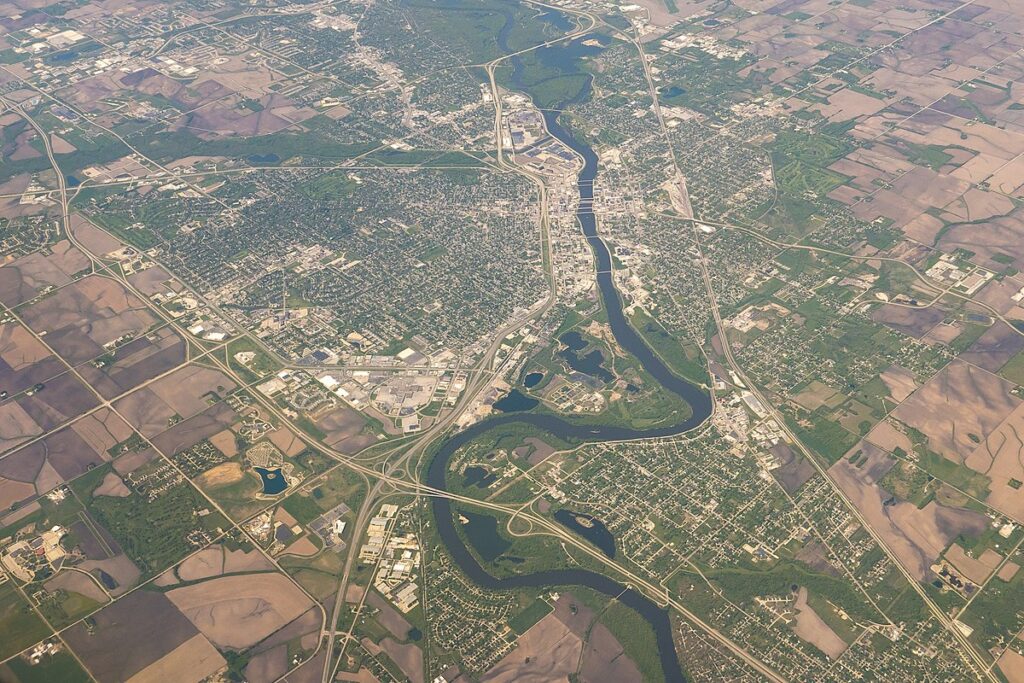
Moving to Waterloo, Iowa: A Comprehensive Relocation Guide
Considering moving to Waterloo, Iowa? This historic manufacturing city offers affordable living, John Deere presence, and working-class character. With approximately 67,000 residents in 2025 (metro 168,000+ with Cedar Falls), Waterloo combines industrial heritage with Cedar River beauty and Northeast Iowa’s largest city.
Demographic Profile to Consider If Moving to Waterloo:
Waterloo’s 2025 population is approximately 67,000 residents, forming a twin-city metro with Cedar Falls totaling over 168,000 in Black Hawk County. The median age is around 36 years, with working families, John Deere employees, and diverse residents. The population is approximately 75% White, 16% Black or African American, 5% Hispanic, 2% Asian. Waterloo features John Deere manufacturing facilities dominating employment, historic downtown, Cedar River providing recreation, and serves as the twin cities’ larger, more industrial community. The city attracts working families seeking manufacturing employment, diverse residents, and those wanting affordable Northeast Iowa living. Waterloo appeals to working-class residents prioritizing affordability and stable manufacturing jobs. The community balances John Deere heritage with economic challenges and maintaining working-class identity. Find trusted local services for moving, living, and working in Waterloo.Waterloo Relocation Directory
Cost of Living to Consider If Moving to Waterloo:
Waterloo offers exceptional affordability. Median home values range from $110,000 to $170,000 in 2025, among Iowa’s most affordable while John Deere provides good union wages. The median household income is approximately $50,000. Rental properties average $700 to $1,000 monthly. Iowa has no state income tax on retirement income; individual income tax is progressive 0.33%-8.53%. Property taxes are moderate. Overall cost of living is very low, making Waterloo highly attractive for working families, John Deere employees, and those seeking maximum Iowa affordability. The city provides tremendous value with stable manufacturing employment. Housing costs create exceptional accessibility with union wages enabling comfortable living on manufacturing incomes.
Economy and Job Market:
Waterloo’s economy depends heavily on John Deere manufacturing operations (Waterloo Works and other facilities) employing thousands in production, engineering, and support. Deere dominates employment and economic stability. Tyson Foods operates a facility. UnityPoint Health-Allen Hospital and healthcare provide employment. Target has a distribution center. Typical industries include manufacturing, healthcare, food processing, and logistics. The economy depends on John Deere’s health and agricultural equipment demand. Union manufacturing jobs offer good wages and benefits. The job market attracts working-class families seeking stable manufacturing employment with benefits.
Education:
Waterloo Community School District serves city students with multiple high schools including East and West. School quality varies dramatically requiring extensive family research with some schools struggling. Hawkeye Community College provides higher education and vocational programs. The educational infrastructure serves the large, working-class, diverse population with quality varying significantly by school and neighborhood.
Recreation and Lifestyle:
Waterloo offers Cedar River providing scenic beauty with Cedar Valley Nature Trail and riverfront parks. The city features the Grout Museum District (history and science museums), the Waterloo Center for the Arts, Lost Island Waterpark (major regional attraction), and John Deere Tractor & Engine Museum. Residents enjoy Isle Casino Hotel Waterloo, My Waterloo Days festival, and proximity to Cedar Falls (immediately adjacent) for UNI athletics and college amenities. The lifestyle emphasizes affordable working-class living, John Deere pride, Cedar River recreation, and twin-cities metro access. The four-season Iowa climate enables varied activities. The community values John Deere heritage (manufacturing built the city), working-class identity, affordability, and union traditions. Living in Waterloo means accepting working-class character, significant variation in neighborhood quality, some urban challenges, economic dependence on John Deere, and being Cedar Falls’ grittier twin while enjoying exceptional affordability, stable union manufacturing employment with good wages and benefits, Lost Island Waterpark, and Cedar River beauty creating Northeast Iowa’s working-class manufacturing hub where John Deere meets maximum affordability.
Healthcare and Services:
Waterloo residents access comprehensive healthcare through UnityPoint Health-Allen Hospital, Covenant Medical Center, and facilities throughout the twin cities. The regional healthcare infrastructure serves Northeast Iowa with quality medical care.
Transportation:
Waterloo is accessed via U.S. Route 20, U.S. Route 218, and various corridors. Waterloo Regional Airport provides limited commercial service. MET Transit operates bus service throughout Waterloo and Cedar Falls. Most residents use personal vehicles. Typical travel times to Cedar Rapids are 1 hour, Des Moines 1.5 hours.
Conclusion:
Moving to Waterloo in 2025 offers affordable manufacturing city living with John Deere employment, Cedar River beauty, and working-class character. The city’s combination of exceptionally low housing costs, stable union manufacturing jobs, and Lost Island Waterpark makes it ideal for working families, John Deere employees, and those seeking Iowa’s most affordable option where manufacturing heritage meets exceptional value and union wages define Northeast Iowa’s working-class hub.

